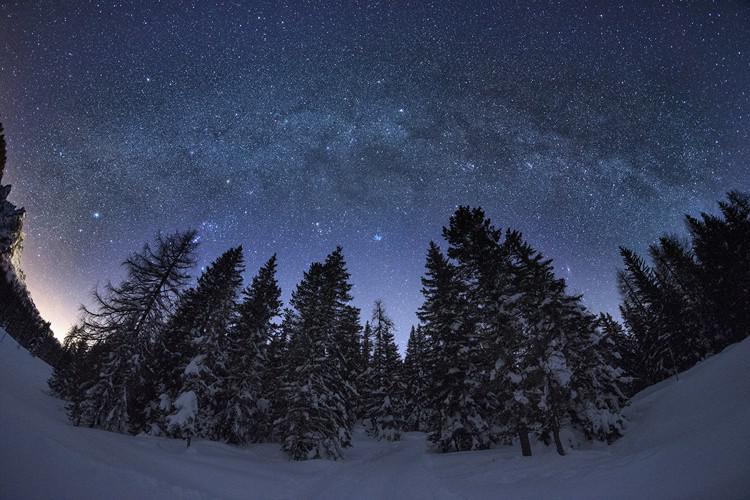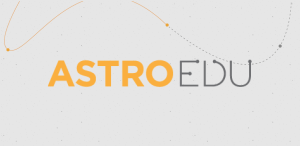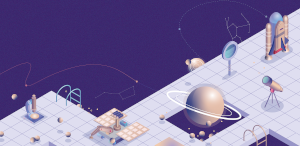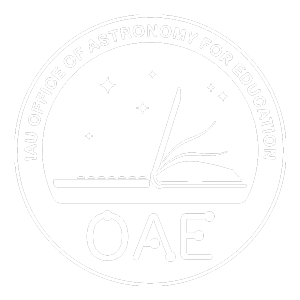This page describes an image Winter Milky Way
Image caption:
Winner in the 2022 IAU OAE Astrophotography Contest, category Still images of celestial patterns.
Taken near Lake Misurina in the Veneto region of Italy in February 2019, this image shows a clear and starry sky over a winter landscape.
We can see part of the Milky Way arc. From the left side, towards the south-east, we see Sirius, "The Burner" in Greek, the brightest star in the night sky. It is part of the constellation Canis Major, The Great Dog, one of the dogs of Orion, the great hunter, in Greek mythology. Orion’s other dog, Canis Minor, the Small Dog, is represented by the bright star Procyon and its fainter neighbours. The Greek star name means “The One [rising] before The Dog” and the star is seen at the top left side of the image just above the arc of the Galaxy. Orion lies to the right of Canis Major. We can spot its characteristic “belt”, an asterism composed of three bright stars aligned in a straight line.
Above the treetops to the right of Orion, the open star clusters of the Hyades and the Pleiades in the constellation Taurus, the Bull, are visible. According to ancient lore, these two clusters form a Celestial Gate directly next to the intersection of the great circles of the ecliptic and the Milky Way. In Greco-Roman mythology, Taurus is associated with the god Zeus who is said to have used a bull to seduce the Phoenician princess Europa.
Above the constellation Taurus, we can see a bright star just above the arc of the Galaxy. This is Capella, the brightest star of the constellation Auriga, The Charioteer. This is one of the 88 modern constellations and is associated with the Greek hero Erichthonius of Athens. Hindu astronomy considers Capella as the heart of Brahma, one of the three major gods. The indigenous people of Bororo in Brazil have a constellation representing a cayman, comprising some of the stars of Auriga and some stars from neighbouring constellations.
To the right of Taurus, we find the modern constellation Perseus with the bright double star cluster h+chi Perseii, which represents the metal of Perseus’s sabre in Greek mythology. Perseus is the hero who was sent out to prove himself, and happened to rescue Andromeda from the sea monster Cetus as the Roman poet Ovid wrote. We can also see the constellation Cassiopeia, associated with the queen and mother of Andromeda in Greek mythology. It is composed of five bright stars in the shape of a W, which was considered the asterism of The Key by the Greeks according to the poet Aratus. The recognisable shape is also associated with other mythologies: for instance, it represents the princess Sharmishtha in Hindu astronomy, a bat in Thailand, and a camel in native Arabic astronomy.
In the gap between the trees, the Andromeda Galaxy is visible.
Scroll to captions in other languages
Image credit:
Giorgia Hofer/IAU OAE
DOI: 10.5281/zenodo.7425158
Related glossary terms:
Andromeda Galaxy
, Milky Way
, Pleiades
, Taurus
Categories:
Galaxies
, Milky Way and Interstellar Medium
, Naked Eye Astronomy
Image license: Creative Commons Attribution 4.0 International (CC BY 4.0) Creative Commons Attribution 4.0 International (CC BY 4.0) icons
The media file captions presented on the OAE website were written, translated and reviewed by a collective effort from the OAE, the OAE Centers and Nodes, the OAE National Astronomy Education Coordinators (NAECs) and other volunteers. You can find a full list of credits for our translation project here. All media file captions are released under a Creative Commons CC BY-4.0 license and should be credited to "IAU OAE". The media files themselves may have different licenses (see above) and should be credited as listed above under "credit".
If you notice a factual error in this caption or an error in any of its translations then please get in touch.
Captions in Different Languages:
Image caption: Auszeichnung beim IAU OAE Astrofoto-Wettbewerb 2022, Kategorie Weitwinkelaufnahmen von Himmelsmustern.
Dieses Bild wurde im Februar 2019 in der Nähe des Misurina-Sees in den Dolomiten in der italienischen Region Venetien aufgenommen und zeigt den Sternhimmel über einer Winterlandschaft.
Die Milchstraße spannt dabei einen Bogen auf. Links, in Richtung Südosten, sehen wir Sirius (abgeleitet aus dem Griechischen: "der Brenner"), den hellsten Stern am Nachthimmel. Er gehört zum Sternbild Großer Hund (Canis Major), der in der griechischen Mythologie einer der Hunde des großen Jägers Orion ist. Der andere Hund des Orion, der Kleine Hund (Canis Minor), wird durch den hellen Stern Procyon und seine schwächeren Nachbarn repräsentiert. Der griechische Name des Sterns bedeutet "Der vor dem Hund [aufgehende]", und er ist oben links auf dem Bild direkt über dem Milchstraßenbogen zu sehen. Orion liegt rechts vom Großen Hund. Wir können seinen charakteristischen "Gürtel" erkennen, eine Sterngruppe, die aus drei hellen Sternen besteht, die in einer geraden Linie angeordnet sind.
Über den Baumkronen rechts vom Orion sind die offenen Sternhaufen der Hyaden und der Plejaden im Sternbild Stier sichtbar. Nach antiker Überlieferung bilden diese beiden Sternhaufen ein Himmelstor direkt neben dem Schnittpunkt der Großkreise von Ekliptik und Milchstraße. In der griechisch-römischen Mythologie wird der Stier mit dem Gott Zeus in Verbindung gebracht, der sich als Stier getarnt haben soll, um die phönizische Prinzessin Europa zu verführen.
Über dem Sternbild Stier steht ein heller Stern direkt über dem Milchstraßenbogen: Capella, der hellste Stern des Sternbilds Fuhrmann (lat. Auriga). Es ist eins der 88 modernen Sternbilder und wird mit dem griechischen Helden Erichthonius von Athen in Verbindung gebracht. In der hinduistischen Astronomie gilt Capella als das Herz von Brahma, einem der drei Hauptgötter. Die Ureinwohner von Bororo in Brasilien haben ein Sternbild, das einen Kaiman darstellt und einige Sterne des Fuhrmanns und weitere Sterne aus benachbarten Sternbildern enthält.
Rechts vom Stier befindet sich das moderne Sternbild Perseus mit dem hellen Doppel-Sternhaufen h+chi Persei, der in der griechischen Mythologie die Klinge des Säbels von Perseus darstellt, eines Helden, der ausgesandt wurde, um sich zu beweisen, und der zufällig Andromeda vor dem Meeresungeheuer Cetus rettete, wie der römische Dichter Ovid beschrieb. Wir können auch das Sternbild Kassiopeia erkennen, das in der griechischen Mythologie mit der Königin und Mutter von Andromeda in Verbindung gebracht wird. Es besteht aus fünf hellen Sternen in der Form eines W, das nach dem Dichter Aratus von den Griechen als Schlüssel angesehen wurde. Die wiedererkennbare Form wird auch mit anderen Mythologien in Verbindung gebracht: So stellt sie beispielsweise in der hinduistischen Astronomie die Prinzessin Sharmishtha dar, in Thailand eine Fledermaus und in der arabischen Astronomie ein Kamel.
In der Lücke zwischen den Bäumen befindet sich die Andromeda-Galaxie.
Image credit: Giorgia Hofer/IAU OAE
Related glossary terms: Andromedagalaxie , Milchstraße , Plejaden , Stier Caption translation status: Not yet approved by a reviewer
Caption translators: Carolin Liefke
Image caption: Vincitore del concorso di astrofotografia IAU OAE 2022, categoria Immagini fisse di modelli celesti.
Scattata vicino al Lago di Misurina, in Veneto, Italia, nel febbraio 2019, questa immagine mostra un cielo limpido e stellato su un paesaggio invernale.
Possiamo vedere parte dell'arco della Via Lattea. Dal lato sinistro, verso sud-est, si vede Sirio, "Il Bruciatore" in greco, la stella più luminosa del cielo notturno. Fa parte della costellazione del Cane Maggiore, uno dei cani di Orione, il grande cacciatore, nella mitologia greca. L'altro cane di Orione, il Cane Minore, è rappresentato dalla stella luminosa Procione e dalle sue vicine più deboli. Il nome greco della stella significa "Quella che sorge prima del Cane" e la stella si vede in alto a sinistra nell'immagine, appena sopra l'arco della Galassia. Orione si trova a destra del Cane Maggiore. Si può notare la sua caratteristica "cintura", un asterismo composto da tre stelle luminose allineate in linea retta.
Sopra le cime degli alberi a destra di Orione, sono visibili gli ammassi stellari aperti delle Iadi e delle Pleiadi nella costellazione del Toro. Secondo l'antica tradizione, questi due ammassi formano una Porta Celeste proprio accanto all'intersezione dei grandi cerchi dell'eclittica e della Via Lattea. Nella mitologia greco-romana, il Toro è associato al dio Zeus, che si dice abbia usato un toro per sedurre la principessa fenicia Europa.
Sopra la costellazione del Toro, possiamo vedere una stella luminosa appena sopra l'arco della Galassia. Si tratta di Capella, la stella più luminosa della costellazione dell'Auriga, il cocchiere. È una delle 88 costellazioni moderne ed è associata all'eroe greco Erittonio di Atene. L'astronomia indù considera Capella come il cuore di Brahma, una delle tre divinità principali. Gli indigeni di Bororo, in Brasile, hanno una costellazione che rappresenta un caimano, comprendente alcune stelle dell'Auriga e alcune stelle delle costellazioni vicine.
A destra del Toro, troviamo la moderna costellazione di Perseo con il luminoso ammasso di stelle doppie h+chi Perseii, che rappresenta il metallo della sciabola di Perseo nella mitologia greca. Perseo è l'eroe che fu inviato a mettersi alla prova e che per caso salvò Andromeda dal mostro marino Cetus, come scrisse il poeta romano Ovidio. Possiamo anche vedere la costellazione di Cassiopea, associata alla regina e madre di Andromeda nella mitologia greca. È composta da cinque stelle luminose a forma di W, che secondo il poeta Arato era considerato l'asterismo della Chiave dai greci. La forma riconoscibile è associata anche ad altre mitologie: ad esempio, rappresenta la principessa Sharmishtha nell'astronomia indù, un pipistrello in Thailandia e un cammello nell'astronomia araba originaria.
Nello spazio tra gli alberi è visibile la Galassia di Andromeda.
Image credit: Giorgia Hofer/IAU OAE
Related glossary terms: Galassia di Andromeda , Pleiadi , Toro , Via Lattea Caption translation status: Approved by a reviewer
Caption translators: Giuliana Giobbi
Caption reviewers: Rodolfo Canestrari, Raffaella Ferretti
Image caption: 2022 年国际天文学联合会 OAE 天体摄影比赛静态天体图案类获奖作品。
本影像摄于2019年2月意大利威尼托大区的密苏里纳湖(Lago di Misurina),呈现冬夜星空与雪原交辉的奇景。
银河弧光下,夜空中最亮的天狼星(Sirius/大犬座α)闪耀于东南方。在希腊神话中,这颗"燃烧者"隶属猎户座忠犬——大犬座(Canis Major)。其左侧的小犬座(Canis Minor)以"先犬星"(Procyon/南河三)为主导,该星名暗示其先于天狼星升起的特性。猎户座位于大犬座右侧,其标志性"腰带三星"清晰可辨。
猎户座右上方树冠处,金牛座的毕宿星团(Hyades)与昴星团(Pleiades)构成传说中的"天界之门",此处恰为黄道与银河两大天球基准圈的交汇点。希腊神话中,金牛化身喻指宙斯诱拐腓尼基公主欧罗巴的传说。
金牛座上方银河弧缘,御夫座主星五车二(Capella)粲然生辉。这颗恒星在印度教中被视为创世神梵天之心,而巴西博罗罗原住民则将御夫座部分星群与邻座恒星共组"凯门鳄星座"。
金牛座右侧可见英仙座(Perseus),其内的英仙座h+χ双星团被古希腊人视为英雄珀尔修斯神剑的寒光。这位斩杀海怪、解救安德洛墨达的传奇人物,其故事经奥维德史诗流传至今。影像中同样可见呈W形的仙后座(Cassiopeia)——希腊诗人阿拉托斯笔下象征"天国之钥"的星群,在印度天文传统中对应莎米什塔公主,在泰国喻指蝙蝠,于阿拉伯古星象中则化身骆驼。
林木间隙处,肉眼可辨的仙女座星系(Andromeda Galaxy)静静悬浮。
Image credit: Giorgia Hofer/IAU OAE
Related glossary terms: 仙女座星系 , 昴宿星团 , 金牛座 , 银河系 Caption translation status: Not yet approved by a reviewer
Caption translators: Lin Shijie
Image caption: 2022 年國際天文學聯合會 OAE 天體攝影比賽靜態天體圖案類獲獎作品。
本影像攝於2019年2月意大利威尼託大區的密蘇里納湖(Lago di Misurina),呈現冬夜星空與雪原交輝的奇景。
銀河弧光下,夜空中最亮的天狼星(Sirius/大犬座α)閃耀於東南方。在希臘神話中,這顆"燃燒者"隸屬獵戶座忠犬——大犬座(Canis Major)。其左側的小犬座(Canis Minor)以"先犬星"(Procyon/南河三)為主導,該星名暗示其先於天狼星升起的特性。獵戶座位於大犬座右側,其標誌性"腰帶三星"清晰可辨。
獵戶座右上方樹冠處,金牛座的畢宿星團(Hyades)與昴星團(Pleiades)構成傳說中的"天界之門",此處恰為黃道與銀河兩大天球基準圈的交匯點。希臘神話中,金牛化身喻指宙斯誘拐腓尼基公主歐羅巴的傳說。
金牛座上方銀河弧緣,御夫座主星五車二(Capella)粲然生輝。這顆恆星在印度教中被視為創世神梵天之心,而巴西博羅羅原住民則將御夫座部分星群與鄰座恆星共組"凱門鱷星座"。
金牛座右側可見英仙座(Perseus),其內的英仙座h+χ雙星團被古希臘人視為英雄珀爾修斯神劍的寒光。這位斬殺海怪、解救安德洛墨達的傳奇人物,其故事經奧維德史詩流傳至今。影像中同樣可見呈W形的仙後座(Cassiopeia)——希臘詩人阿拉托斯筆下象徵"天國之鑰"的星群,在印度天文傳統中對應莎米什塔公主,在泰國喻指蝙蝠,於阿拉伯古星象中則化身駱駝。
林木間隙處,肉眼可辨的仙女座星系(Andromeda Galaxy)靜靜懸浮。
Image credit: Giorgia Hofer/IAU OAE
Related glossary terms: 仙女座星系 , 昴宿星團 , 金牛座 , 銀河系 Caption translation status: Not yet approved by a reviewer
Caption translators: An automated transliteration from the simplified Chinese translation by - Lin Shijie









